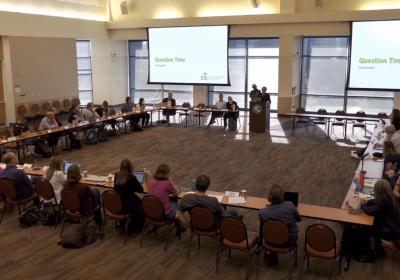
Ohio’s higher education overhaul bill advances: What’s next for CSU?
The Ohio House passed the higher education overhaul Senate Bill 1 last week. Ohio's Gov. Mike DeWine’s is expected to sign the bill into law, despite opposition from educators, students, education experts and rights groups across the state.
Among other changes, if signed into law SB1 would give the state more control over Ohio’s public colleges and universities, ban civic rights-oriented programs which promote diversity, equity and inclusion, restrict academic freedom and prohibit faculty strikes.
As a publicly funded university, Cleveland State will be directly impacted.
What’s on SB1?
Ohio Senate Bill 1 was introduced to the state legislature in late January and is sponsored by state senator Jerry Cirino D-18, a Republican from Kirtland.
“Ohio is going to be at the top of the heap in higher education reform,” Cirino said at a press conference Jan. 22.
The 75-page bill is Cirino's second attempt to impose on the state the views enshrined in the legislation. His first attempt, SB83, from 2023, was stopped after Republican Ohio House Speaker Jason Stephens in November 2024 said he would not bring the bill to the Ohio House floor for a vote.
However, after years of Republican infighting, Matt Huffman, a Lima Republican and supporter of SB1, replaced Stephens in early January as Ohio House speaker, opening the way for Cirino to revive the bill, which critics describe as even more draconian than its predecessor.
SB1 will mandate that universities implement “intellectual-diversity” of views, end DEI practices and ban faculty striking. The bill would also force universities to implement a mandatory 3-credit civics class for students to be able to graduate.
Signal Cleveland reported that CSU would need to spend up to $400,000 to implement a new mandatory civics course, which would likely add to the university’s already ballooning budget deficit.
Critics of SB1
Critics of the bill argue that SB1 is an attempt by the Ohio republican caucus to force institutions to embrace conservative ideology.
The bill has also been perceived by many as inherently anti-union with its ban on faculty striking.
“This bill would suppress students’ freedom to learn about, research, and understand the topics they are interested in and this bill would drive up the cost of tuition by placing more bureaucratic unfunded mandates on colleges and universities,” Sara Kilpatrick, Executive Director of the Ohio Conference of the American Association of University Professors, said in a press release shortly after the bill was first introduced.
In the weeks following the bill’s proposal, many public universities erupted in protest as students and faculty voiced their opposition, including with protests outside the Ohio Statehouse in Columbus.
Cleveland State made clear it is not going to pre-emptively comply with the legislation, but would comply with the law if DeWine signs the bill.
“As a general rule, almost a principle, we are not going to act precipitously,” President Bloomberg said about the bill last week at an SGA listening session. “We are in compliance with the current law, and we will stay that way until forces suggest that we must change.”
Faculty Senate President Olszewski briefly acknowledged the potential impact of the bill at last month’s faculty senate meeting stating, “There are some very clear objectives in this legislation, but there are also some unclear targets," Olszewski said. "We will be affected by this legislation,” she added, without going into detail about the possibilities of how.
If, as expected, Gov. DeWine signs SB1, universities will have 90 days to prepare before the law officially takes effect.
To read more about SB1, and track its progress to the governor’s desk visit the Ohio Legislature website.




















